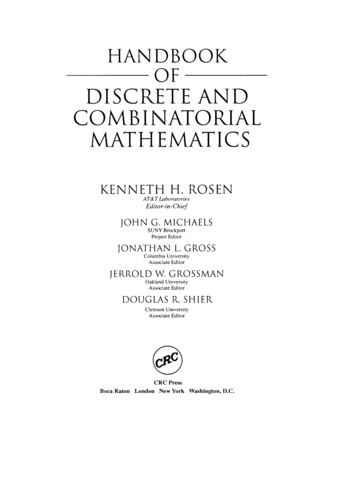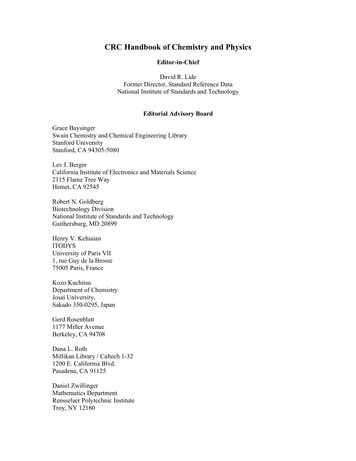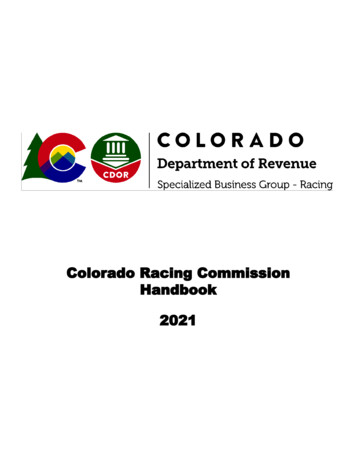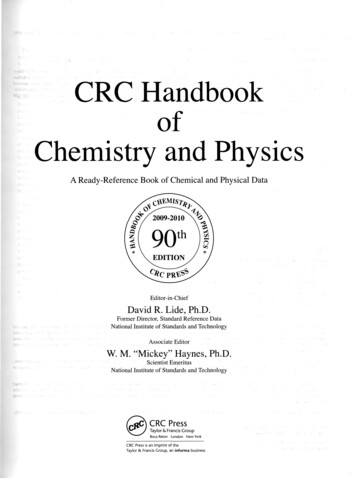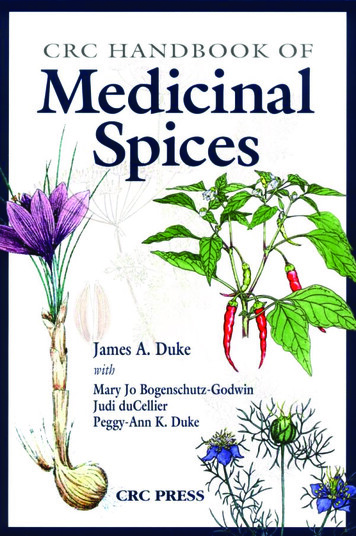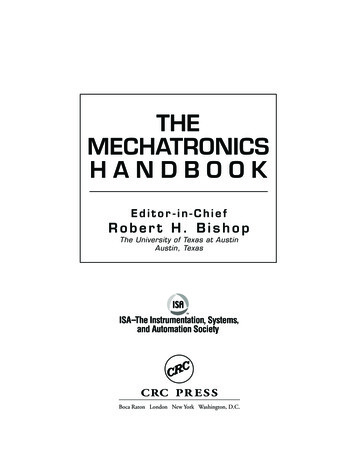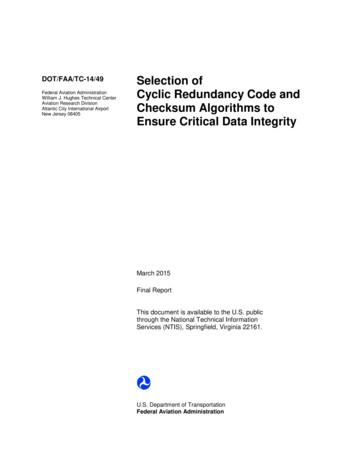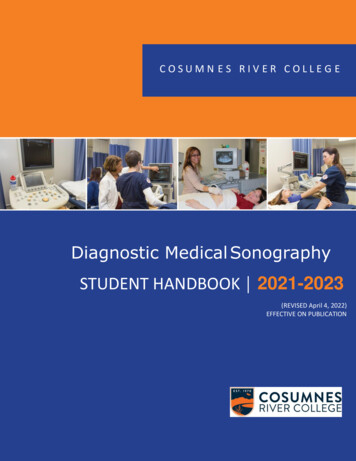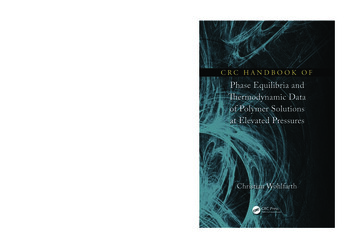
Transcription
Industrial ChemistryWohlfarthCRC HANDBOOK OFCRC HANDBOOK OFPhase Equilibria and Thermodynamic Dataof Polymer Solutions at Elevated PressuresPhase Equilibria andThermodynamic Dataof Polymer Solutionsat Elevated PressuresThermodynamic data of polymer solutions are paramount for industrial andlaboratory processes. These data also serve to understand the physical behavior ofpolymer solutions, study intermolecular interactions, and gain insights into themolecular nature of mixtures.Nearly a decade has passed since the release of a similar CRC Handbook andduring that time a large amount of new experimental data have been published,which is now compiled in this book.The CRC Handbook of Phase Equilibria and Thermodynamic Data ofPolymer Solutions at Elevated Pressures features nearly 500 newly publishedreferences containing approximately 175 new vapor-liquid equilibrium data sets,25 new liquid-liquid equilibrium data sets, 540 new high-pressure fluid phaseequilibrium data sets, 60 new data sets describing PVT properties of polymers,and 20 new data sets with densities or excess volumes.The book is a valuable resource for researchers, specialists, and engineers workingin the fields of polymer science, physical chemistry, chemical engineering,materials science, biological science and technology, and those developingcomputerized predictive packages.CRC HANDBOOK OFPhase Equilibria andThermodynamic Dataof Polymer Solutionsat Elevated PressuresChristian WohlfarthK24650ISBN: 978-1-4987-0320-8900009 781498 703208K24650 Cover mech.indd All Pages1/8/15 9:51 AM
CRC HANDBOOK OFPhase Equilibria andThermodynamic Dataof Polymer Solutionsat Elevated PressuresK24650 FM.indd 112/10/14 11:14 AM
K24650 FM.indd 212/10/14 11:14 AM
CRC HANDBOOK OFPhase Equilibria andThermodynamic Dataof Polymer Solutionsat Elevated PressuresChristian WohlfarthK24650 FM.indd 312/10/14 11:14 AM
CRC PressTaylor & Francis Group6000 Broken Sound Parkway NW, Suite 300Boca Raton, FL 33487-2742 2015 by Taylor & Francis Group, LLCCRC Press is an imprint of Taylor & Francis Group, an Informa businessNo claim to original U.S. Government worksVersion Date: 20141125International Standard Book Number-13: 978-1-4987-0321-5 (eBook - PDF)This book contains information obtained from authentic and highly regarded sources. Reasonable efforts have beenmade to publish reliable data and information, but the author and publisher cannot assume responsibility for the validity of all materials or the consequences of their use. The authors and publishers have attempted to trace the copyrightholders of all material reproduced in this publication and apologize to copyright holders if permission to publish in thisform has not been obtained. If any copyright material has not been acknowledged please write and let us know so we mayrectify in any future reprint.Except as permitted under U.S. Copyright Law, no part of this book may be reprinted, reproduced, transmitted, or utilized in any form by any electronic, mechanical, or other means, now known or hereafter invented, including photocopying, microfilming, and recording, or in any information storage or retrieval system, without written permission from thepublishers.For permission to photocopy or use material electronically from this work, please access www.copyright.com (http://www.copyright.com/) or contact the Copyright Clearance Center, Inc. (CCC), 222 Rosewood Drive, Danvers, MA 01923,978-750-8400. CCC is a not-for-profit organization that provides licenses and registration for a variety of users. Fororganizations that have been granted a photocopy license by the CCC, a separate system of payment has been arranged.Trademark Notice: Product or corporate names may be trademarks or registered trademarks, and are used only foridentification and explanation without intent to infringe.Visit the Taylor & Francis Web site athttp://www.taylorandfrancis.comand the CRC Press Web site athttp://www.crcpress.com
CONTENTSPreface . .viiAbout the Author . .ix1. INTRODUCTION1.1.1.2.1.3.1.4.1.5.Objectives of the handbook . 1Experimental methods involved . .2Guide to the data tables . .7List of symbols . .11References . 132. VAPOR-LIQUID EQUILIBRIUM (VLE) DATA ANDGAS SOLUBILITIES AT ELEVATED PRESSURES2.1.2.2.2.3.2.4.2.5.Binary polymer solutions.15Table of binary systems where data were published only ingraphical form as phase diagrams or related figures.89Ternary and quaternary polymer solutions.102Table of ternary or quaternary systems where data were publishedonly in graphical form as phase diagrams or related figures.138References.1423. LIQUID-LIQUID EQUILIBRIUM (LLE) DATA OFPOLYMER SOLUTIONS AT ELEVATED PRESSURES3.1.3.2.3.3.3.4.3.5.Cloud-point and/or coexistence curves of quasibinary solutions.157Table of binary systems where data were published only ingraphical form as phase diagrams or related figures.172Cloud-point and/or coexistence curves of quasiternary solutionsand/or quasiquaternary solutions.174Table of ternary or quaternary systems where data were publishedonly in graphical form as phase diagrams or related figures.178References.180v
4. HIGH-PRESSURE FLUID PHASE EQUILIBRIUM (HPPE)DATA OF POLYMER SOLUTIONS4.1.4.2.4.3.4.4.4.5.Cloud-point and/or coexistence curves of quasibinary solutions.183Table of binary systems where data were published only ingraphical form as phase diagrams or related figures.299Cloud-point and/or coexistence curves of quasiternary solutionsand/or quasiquaternary solutions.308Table of ternary or quaternary systems where data were publishedonly in graphical form as phase diagrams or related figures.452References .4575. PVT DATA OF POLYMERS AND SOLUTIONS5.1.5.2.5.2.1.5.2.2.5.3.PVT data of polymers.469PVT data of polymer solutions.512Binary polymer solutions.512Ternary polymer solutions.521References.534APPENDICESAppendix 1Appendix 2Appendix 3Appendix 4List of polymers in alphabetical order . . . .537List of systems and properties in order of the polymers . . .545List of solvents in alphabetical order . .571List of solvents in order of their molecular formulas . . .578INDEX . .585vi
PREFACEToday, there is still a strong and continuing interest in thermodynamic properties ofpolymer solutions at elevated pressures. Thus, about ten years after the CRC Handbook ofThermodynamic Data of Polymer Solutions at Elevated Pressures was published, necessity as wellas desire arises for a supplementary book that includes and provides newly published experimentaldata from the last decade.There are about 500 newly published references containing about 175 new vapor-liquidequilibrium data sets, 25 new liquid-liquid equilibrium data sets, 540 new high-pressure fluidphase equilibrium data sets, 60 new data sets describing PVT-properties of polymers, and 20 newdata sets with densities or excess volumes. So, in comparison to the original handbook, the newsupplementary volume contains even a larger amount of data and will be a useful as well asnecessary completion of the original handbook.The Supplement will be divided into the five chapters: (1) Introduction, (2) Vapor-LiquidEquilibrium (VLE) Data and Gas Solubilities at Elevated Pressures, (3) Liquid-Liquid Equilibrium(LLE) Data of Polymer Solutions at Elevated Pressures, (4) High-Pressure Fluid Phase Equilibrium(HPPE) Data of Polymer Solutions, (5) PVT Data of Polymers and Solutions. Finally, appendicesquickly route the user to the desired data sets.Additionally, tables of systems are provided where results were published only ingraphical form in the original literature to lead the reader to further sources. Data are included onlyif numerical values were published or authors provided their numerical results by personalcommunication (and I wish to thank all those who did so). No digitized data have been included inthis data collection.The closing date for the data compilation was June 30, 2014. However, the user who is inneed of new additional data sets is kindly invited to ask for new information beyond this book viae-mail at christian.wohlfarth@chemie.uni-halle.de. Additionally, the author will be grateful to allusers who call his attention to mistakes and make suggestions for improvements.The new CRC Handbook of Phase Equilibria and Thermodynamic Data of PolymerSolutions at Elevated Pressures will again be useful to researchers, specialists, and engineersworking in the fields of polymer science, physical chemistry, chemical engineering, materialsscience, biological science and technology, and those developing computerized predictivepackages. The book should also be of use as a data source to Ph.D. students and faculty inchemistry, physics, chemical engineering, biotechnology, and materials science departments atuniversities.Christian Wohlfarthvii
About the AuthorChristian Wohlfarth is associate professor for physical chemistry at Martin-LutherUniversity Halle-Wittenberg, Germany. He earned his degree in chemistry in 1974 and wrote hisPh.D. thesis in 1977 on investigations of the second dielectric virial coefficient and theintermolecular pair potential, both at Carl Schorlemmer Technical University Merseburg. In 1985,he wrote his habilitation thesis, Phase Equilibria in Systems with Polymers and Copolymers, at theTechnical University Merseburg.Since then, Dr. Wohlfarth’s main research has been related to polymer systems. Currently,his research topics are molecular thermodynamics, continuous thermodynamics, phase equilibria inpolymer mixtures and solutions, polymers in supercritical fluids, PVT behavior and equations ofstate, and sorption properties of polymers, about which he has published approximately 100original papers. He has written the following books: Vapor-Liquid Equilibria of Binary PolymerSolutions, CRC Handbook of Thermodynamic Data of Copolymer Solutions, CRC Handbook ofThermodynamic Data of Aqueous Polymer Solutions, CRC Handbook of Thermodynamic Data ofPolymer Solutions at Elevated Pressures, CRC Handbook of Enthalpy Data of Polymer-SolventSystems, CRC Handbook of Liquid-Liquid Equilibrium Data of Polymer Solutions, CRC Handbookof Phase Equilibria and Thermodynamic Data of Copolymer Solutions, and CRC Handbook ofPhase Equilibria and Thermodynamic Data of Aqueous Polymer Solutions.He is working on the evaluation, correlation, and calculation of thermophysical propertiesof pure compounds and binary mixtures resulting in eleven volumes of the Landolt-Börnstein NewSeries. He is a contributor to the CRC Handbook of Chemistry and Physics.ix
1. INTRODUCTION1.1. Objectives of the handbookKnowledge of thermodynamic data of polymer solutions is a necessity for industrial andlaboratory processes. Furthermore, such data serve as essential tools for understanding the physicalbehavior of polymer solutions, for studying intermolecular interactions, and for gaining insightsinto the molecular nature of mixtures. They also provide the necessary basis for any developmentsof theoretical thermodynamic models. Scientists and engineers in academic and industrial researchneed such data and will benefit from a careful collection of existing data. However, the databasefor polymer solutions at elevated pressures is still modest in comparison with the enormous amountof data for low-molecular mixtures. On the other hand, especially polymer solutions in supercriticalfluids are gaining increasing interest (1994MCH, 1997KIR) because of their unique physicalproperties, and thermodynamic data at elevated pressures are needed for optimizing applications,e.g., separation operations of complex mixtures in the high-pressure synthesis of polymers,recovery of polymer wastes, precipitation, fractionation and purification of polymers, and polymersin green chemistry processes. During the last ten years after the former CRC Handbook ofThermodynamic Data of Polymer Solutions at Elevated Pressures was published, a large amount ofnew experimental data has been published, which is now compiled in this new CRC Handbook ofPhase Equilibria and Thermodynamic Data of Polymer Solutions at Elevated Pressures.Basic information on polymers can still be found in the Polymer Handbook (1999BRA),and there is also a chapter on properties of polymers and polymer solutions in the CRC Handbookof Chemistry and Physics (2011HAY). Older data for polymer solutions at elevated pressures canpartly be found in the data books written by the author of this Handbook (1994WOH, 2001WOH,2004WOH, 2005WOH, 2006WOH, 2008WOH, 2009WOH, 2011WOH, and 2013WOH). At least,polymer solution data are available from the Dortmund Data Bank (2006DDB). The newHandbook provides scientists and engineers with an up-to-date compilation from the literature ofthe available thermodynamic data on polymer solutions at elevated pressures. The Handbook doesnot present theories and models for polymer solution thermodynamics. Other publications(1971YAM, 1990FUJ, 1990KAM, 1999KLE, 1999PRA, and 2001KON) can serve as startingpoints for investigating those issues.The data within this book are divided into four chapters: Vapor-liquid equilibrium (VLE) data and gas solubilities at elevatedpressures Liquid-liquid equilibrium (LLE) data of polymer solutions at elevatedpressures High-pressure fluid phase equilibrium (HPPE) data of polymer solutions PVT data of polymers and solutionsData from investigations applying to more than one chapter are divided and appear in therelevant chapters. Data are included only if numerical values were published or authors providedtheir results by personal communication (and I wish to thank all those who did so). No digitizeddata have been included in this data collection, but a number of tables include systems based ondata published in graphical form as phase diagrams or related figures.
Phase Equilibria and Thermodynamic Data of Polymer Solutions at Elevated Pressures21.2. Experimental methods involvedBesides the common progress in instrumentation and computation, no remarkable newdevelopments have been made with respect to the experimental methods involved here. So, a shortsummary of this chapter should be sufficient for the Handbook. The necessary equations are giventogether with some short explanations only.At higher pressures, the classification of experimental data into vapor-liquid, liquid-liquid,or fluid-fluid equilibrium data is not always simple. Also the expression “elevated pressure” ismore or less relative. With respect to the latter, data are included here if at least some data points ofa system were measured at a pressure above normal pressure. With respect to a classification ofexperimental data into the chapters 2, 3, or 4, practical reasons as well as theoretical considerationsare applied. Theoretical considerations are taken into account for most polymer systems withsubcritical solvents and supercritical fluids. Van Konynenburg and Scott (1980VAN) cited sixclasses of phase diagrams and showed that almost all known types of phase equilibria of binarymixtures can be classified within their scheme. Yelash and Kraska (1999YEL) developed globalphase diagrams for mixtures of spherical molecules with non-spherical molecules also includingpolymers. So, most of the systems in this book could at least be categorized into the correspondingchapters in accordance to their rules. Nevertheless, sometimes problems remain for a number ofsystems with subcritical or supercritical fluid solvents. Therefore, in Chapter 4, the type ofequilibrium within one data set is sometimes stated individually for each data point.Accordingly, a classical discussion of experimental methods for vapor-liquid or liquidliquid equilibrium measurements does not really fit here. Information about experimental methodsfor polymer solutions at ordinary pressures can be found in (1975BON) and (2000WOH) or informer handbooks (e.g., 2001WOH and 2004WOH). Here, the classification also used by Christovand Dohrn (2002CHR) is chosen where experimental methods for the investigation of highpressure phase equilibria are divided into two main classes, depending on how the composition isdetermined: analytical (direct sampling methods) and synthetic (indirect sampling methods).Analytical methodsAnalytical methods involve the determination of the composition of the coexisting phases.This can be done by taking samples from each phase and analyzing them outside the equilibriumcell at normal pressure or by using physicochemical methods of analysis inside the equilibrium cellunder pressure. If one needs the determination of more information than the total polymercomposition, i.e., if one wants to characterize the polymer with respect to molar mass (distribution)or chemical composition (distribution), the sampling technique is unavoidable.Withdrawing a large sample from an autoclave causes a considerable pressure drop, whichdisturbs the phase equilibrium significantly. This pressure drop can be avoided by using a variablevolume cell, by using a buffer autoclave in combination with a syringe pump or by blocking off alarge sampling volume from the equilibrium cell before pressure reduction. If only a small sampleis withdrawn or if a relatively large equilibrium cell is used, the slight pressure drop does not affectthe phase composition significantly. Small samples can be withdrawn using capillaries or specialsampling valves. Often sampling valves are directly coupled to analytical equipment. Analyticalmethods can be classified as isothermal methods, isobaric-isothermal methods, and isobaricmethods.
1. Introduction3Using the isothermal mode, an equilibrium cell is charged with the system of interest, themixture is heated to the desired temperature, and this temperature is then kept constant. Thepressure is adjusted in the heterogeneous region above or below the desired equilibrium valuedepending on how the equilibrium will change pressure. After intensive mixing over the timenecessary for equilibrating the system, the pressure reaches a plateau value. The equilibration timeis the most important point for polymer solutions. Due to their (high) viscosity and slow diffusion,equilibration will often need many hours or even days. The pressure can be readjusted by adding orwithdrawing of material or by changing the volume of the cell if necessary. Before analyzing thecompositions of the coexisting phases, the mixture is usually given some time for a clear phaseseparation. Sampling through capillaries can lead to differential vaporization (especially formixtures containing gases and high-boiling solvents as well) when no precautions have been takento prevent a pressure drop all along the capillary. This problem can be avoided with anexperimental design that ensures that most of the pressure drop occurs at the end of the capillary.Sometimes, one or more phases will be recirculated to reduce sampling problems. The use ofphysicochemical methods of analysis inside the equilibrium cell, e.g., by a spectrometer, avoids theproblems related to sampling. On the other hand, time-consuming calibrations can be necessary. Atthe end, isothermal methods need relatively simple and inexpensive laboratory equipment. Ifcarried out carefully, they can produce reliable results.Isobaric-isothermal methods are often also called dynamic methods. One or more fluidstreams are pumped continuously into a thermostated equilibrium cell. The pressure is keptconstant during the experiment by controlling an effluent stream, usually of the vapor phase. Onecan distinguish between continuous-flow methods and semi-flow methods. In continuous-flowmethods, both phases flow through the equilibrium cell. They can be used only for systems wherethe time needed to attain phase equilibrium is sufficiently short. Therefore, such equipment isusually not applied to polymer solutions. In semi-flow methods, only one phase is flowing whilethe other stays in the equilibrium phase. They are sometimes called gas-saturation methods or puregas circulation methods and can be used to measure gas solubilities in liquids and melts orsolubilities of liquid or solid substances in supercritical fluids.Isobaric methods provide an alternative to direct measurements of pressure-temperaturecompositions in liquid phase compositions in vapor phase (P-T-wL-wV) data. This is themeasurement of (P-T-wL) data followed by a consistent thermodynamic analysis. Such isobaricanalytical methods are usually made in dynamic mode, too.The main advantages of the analytical methods are that systems with more than twocomponents can be studied, several isotherms or isobars can be studied with one filling, and thecoexistence data are determined directly. The main disadvantage is that the method is not suitablenear critical states or for systems where the phases do not separate well. Furthermore, dynamicmethods can be difficult in their application to highly viscous media like concentrated polymersolutions where foaming may cause further problems.Synthetic methodsIn synthetic methods, a mixture of known composition is prepared and the phaseequilibrium is observed subsequently in an equilibrium cell (the problem of analyzing fluidmixtures is replaced by the problem of “synthesizing” them). After known amounts of thecomponents have been placed into an equilibrium cell, pressure and temperature are adjusted so that
Phase Equilibria and Thermodynamic Data of Polymer Solutions at Elevated Pressures4the mixture is homogeneous. Then temperature or pressure is varied until formation of a new phaseis observed. This is the common way to observe cloud points in demixing polymer systems. Nosampling is necessary. The experimental equipment is relatively simple and inexpensive. Formulticomponent systems, experiments with synthetic methods yield less information than withanalytical methods, because the tie lines cannot be determined without additional experiments. Thisis specially true when fractionation accompanies demixing.The appearance of a new phase is either detected visually or by monitoring physicalproperties. Visually, the beginning of turbidity in the system or the meniscus in a view cell can beobserved. Otherwise, light scattering is the common method to detect the formation of the newphase. Both visual and non-visual synthetic methods are widely used in investigations on polymersystems at elevated pressures. The problem of isorefractive systems (where the coexisting phaseshave approximately the same refractive index) does not belong to polymer solutions where theusually strong concentration dependence of their refractive index prevents such a behavior. If thetotal volume of a variable-volume cell can be measured accurately, the appearance of a new phasecan be observed from the abrupt change in the slope of a pressure-volume plot. An example isgiven in Chapter 4. The changes of other physical properties like viscosity, ultrasonic absorption,thermal expansion, dielectric constant, heat capacity, or UV and IR absorption are also applied asnon-visual synthetic methods for polymer solutions.A common synthetic method for polymer solutions is the (P-T-wL) experiment. Anequilibrium cell is charged with a known amount of polymer, evacuated and thermostated to themeasuring temperature. Then the second component (gas, fluid, solvent) is added and the pressureincreases. The second component dissolves into the (amorphous or molten) polymer and thepressure in the equilibrium cell decreases. Therefore, this method is sometimes called the pressuredecay method. Pressure and temperature are registered after equilibration. No samples are taken.The composition of the vapor phase is calculated using a phase equilibrium model if two or moregases or solvents are involved. The determination of the volume of gas or solvent vaporized in theunoccupied space of the apparatus is important as it can cause serious errors in the determination oftheir final concentrations. The composition of the liquid phase is often obtained by weighing andusing the material balance. By repeating the addition of the second component into the cell, severalpoints along the vapor/gas-liquid equilibrium line can be measured. This method is usually appliedfor all gas solubility/vapor sorption/vapor pressure investigations in systems with polymers. Thesynthetic method is particularly suitable for measurements near critical states. Simultaneousdetermination of PVT data is possible.Some problems related to systems with polymersDetails of experimental equipment can be found in the original papers compiled for thisbook and will not be presented here. Only some problems should be summarized that have to beobeyed and solved during the experiment.The polymer solution is often of an amount of some cm3 and may contain about 1g ofpolymer or even more. Therefore, the equilibration of prepared solutions can be difficult andequilibration is usually very time consuming (liquid oligomers do not need so much time, ofcourse). Increasing viscosity makes the preparation of concentrated solutions more and moredifficult with further increasing the amount of polymer. Solutions above 50-60 wt% can hardly beprepared (depending on the solvent/polymer pair under investigation).
1. Introduction5All impurities in the pure solvents have to be eliminated. Degassing of solvents (andsometimes of polymers too) is absolutely necessary. Polymers and solvents must keep dry.Sometimes, inhibitors and antioxidants are added to polymers. They may probably influence theposition of the equilibrium. The thermal stability of polymers must be obeyed, otherwise,depolymerization or formation of networks by chemical processes can change the sample duringthe experiment.Certain principles must be obeyed for experiments where liquid-liquid equilibrium isobserved in polymer-solvent (or supercritical fluid) systems. To understand the results of LLEexperiments in polymer solutions, one has to take into account the strong influence of polymerdistribution functions on LLE, because fractionation occurs during demixing. Fractionation takesplace with respect to molar mass distribution as well as to chemical distribution if copolymers areinvolved. Fractionation during demixing leads to some effects by which the LLE phase behaviordiffers from that of an ordinary, strictly binary mixture, because a common polymer solution is amulticomponent system. Cloud-point curves are measured instead of binodals; and per eachindividual feed concentration of the mixture, two parts of a coexistence curve occur below (forupper critical solution temperature, UCST, behavior) or above the cloud-point curve (for lowercritical solution temperature, LCST, behavior), i.e., produce an infinite number of coexistence data.Distribution functions of the feed polymer belong only to cloud-point data. On the otherhand, each pair of coexistence points is characterized by two new and different distributionfunctions in each coexisting phase. The critical concentration is the only feed concentration whereboth parts of the coexistence curve meet each other on the cloud-point curve at the critical pointthat belongs to the feed polymer distribution function. The threshold point (maximum or minimumcorresponding to either UCST or LCST behavior) temperature (or pressure) is not equal to thecritical point, since the critical point is to be found at a shoulder of the cloud-point curve. Detailswere discussed by Koningsveld (1968KON, 1972KON). Thus, LLE data have to be specified inthe tables as cloud-point or coexistence data, and coexistence data make sense only if the feedconcentration is given. This is not always the case, however.Special methods are necessary to measure the critical point. Only for solutions ofmonodisperse polymers, the critical point is the maximum (or minimum) of the binodal. Binodalsof polymer solutions can be rather broad and flat. Then, the exact position of the critical point canbe obtained by the method of the rectilinear diameter:( B B )T 1 B ,crit (1 )Tcrit2IIIwhere: BI BII B,critTTcrit volume fraction of the polymer B in coexisting phase Ivolume fraction of the polymer B in coexisting phase IIvolume fraction of the polymer B at the critical point(measuring) temperaturecritical temperature (LLE)critical exponent(1)
Phase Equilibria and Thermodynamic Data of Polymer Solutions at Elevated Pressures6For solutions of polydisperse polymers, such a procedure cannot be used because thecritical concentration must be known in advance
The CRC Handbook of Phase Equilibria and Thermodynamic Data of . PDF) This book contains information obtained from authentic and highly regarded sources. Reasonable efforts have been made to publish reliable data and information, but the author
